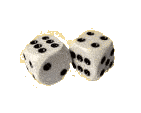Sampling on a grid
 First thing first, what is a random sample?
First thing first, what is a random sample?
- "Sample" in this case means a small amount of something -- like when you sample some ice cream before you buy a whole cone. So, if you sample the population, you count only SMALL parts of it, not the whole population!
- "Random" means you pick the samples randomly. You obviously don't want to count only the densest weedpatches and assume that you can use that to estimate the entire population (unless you're being paid to get rid of them, I guess).
 But humans, left to their own devices, will usually pick areas that are very dense or very sparse, without even realizing it. So, instead we use some way to pick the areas to sample randomly -- this could be dice, or a table of random numbers, or a computer program, or anything that is "mindlessly" random. More on that later...
But humans, left to their own devices, will usually pick areas that are very dense or very sparse, without even realizing it. So, instead we use some way to pick the areas to sample randomly -- this could be dice, or a table of random numbers, or a computer program, or anything that is "mindlessly" random. More on that later...
To count the dandelions, we'll first create a grid, then use the computer's random number generator to tell us which grid squares to count. We'll do this 8 times, because, as you'll see, the counts in the different grid squares will vary a lot.
After you count 8 squares, you'll use the average number per square to estimate the population of the entire lawn.
Look at the applet's final message -- how close was your estimate?
Copyright University of Maryland, 2007
You may link to this site for educational purposes.
Please do not copy without permission
requests/questions/feedback email: mathbench@umd.edu